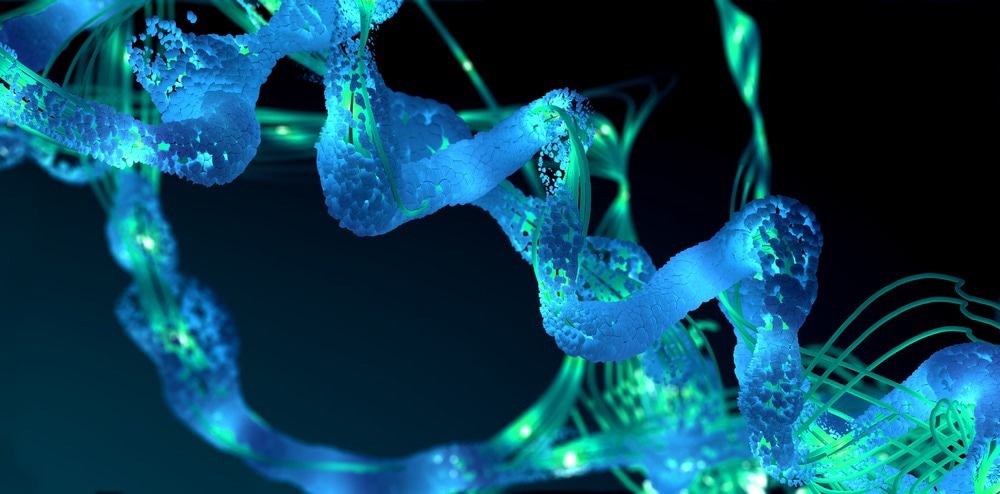The concept of nanopores emerged in the 1990s when their use in DNA sequencing was first proposed.1
Image Credit: Christoph Burgstedt/Shutterstock.com
Nanopores are tiny, nanometer-scale apertures that are synthetically produced in manufactured materials as well as biological membranes. They allow ions or molecules to pass through and have been highly useful in DNA sequencing, protein analysis, and sensor technologies.
For many years, nanopores have been used to analyze proteins at the single-molecule level. Proteins are passed through the nanopores and analyzed during the process. Studies that utilize nanopores can reveal vital information about a protein’s structure, dynamics, and interactions with a high level of accuracy.
Principles of Nanopore Technology
The key principles of nanopore technology include the nanopore’s structure, which can be fabricated from various materials, such as solid materials (like silicon nitride) and biological materials (including protein channels).
Another crucial principle is ion current detection, which is essential for recognizing when molecules pass through nanopores. When molecules move through a membrane, they disrupt the flow of ions in and out of the nanopore, changing the ionic current. Researchers record these changes to make inferences about the properties of the molecules being passed through the nanopores.
Nanopore technology often does not require labeling, making it a valuable tool for analyzing biomolecules in their natural state without modification.
Single-molecule sensing is also critical to the functioning of nanopore technology.2 Current nanopore technology allows individual molecules to pass through a nanopore and be recorded and analyzed in real-time, facilitating high-resolution measurement of the molecule’s properties.
Data analysis is another critical feature of nanopore technology. The signals detected and measured during nanopore studies are processed using specially developed algorithms to extract vital information about the molecules under investigation. Data analysis can interpret signals to infer molecule identity, structure, sequence, and interactions.
Applications of Nanopores in Protein Analysis
Nanopores are used in several key applications in protein analysis. For example, they are used in protein characterization, where nanopore experiments provide real-time data on proteins as they pass through nanopores, helping scientists understand more about their charge, size, structure, and more.
Another significant application is in studying protein-protein interactions. Here, nanopores are used to analyze the translocation behavior of protein complexes, gathering information on how different proteins interact. Studies also use nanopores to obtain information on protein folding structures, which can offer vital insights into protein kinetics.
Protein sequencing is another important application of nanopores in protein analysis. While this application is still relatively new, research has successfully developed nanopore platforms to directly sequence proteins by analyzing their amino acid sequence.
Additionally, nanopores are frequently used to identify drug candidates in drug screening and development, demonstrating their applicability in pharmaceutical research.
Finally, an emerging application of nanopores in protein analysis is in biomarker detection. Scientists increasingly use nanopores in novel diagnostic platforms, linking biomarkers (such as proteins) to various diseases. These platforms are being developed to enable more precise diagnoses and facilitate personalized medicine.3
Advantages and Limitations of Nanopore-Based Protein Analysis
There are many advantages of nanopore-based protein analysis. One significant advantage is its single-molecule sensitivity, which allows for the study of proteins at the single-molecule level, enabling high sensitivity and the ability to detect low-abundance proteins.
Another key advantage is label-free detection; nanopore-based protein analysis often does not require protein modification.
Nanopore-based protein analysis platforms are also high throughput, meaning they can analyze many proteins simultaneously. This increases the efficiency of the analytical process and reduces study time.
Nanopores also allow for real-time monitoring, an advantage that enables the dynamic measurement of protein properties, including size and charge.
Finally, in recent years, scientists have established novel, miniaturized nanopore devices that offer portable point-of-care applications, allowing easy access to diagnostics in underserved areas.4
Future Directions and Potential Impact of Nanopores in Protein Research
In the future, several enhancements in the use of nanopores in protein research may be observed. For example, enhanced resolution, specificity, and the integration of advanced sensing technologies are likely to benefit nanopore applications in fields such as drug discovery, personalized medicine, and structural biology.
The continued development of portable nanopore platforms could enhance point-of-care diagnostics and impact global healthcare access. Overall, nanopores, like other nanosized structures, are expected to remain a key focus of future research and development. Nanopore-based platforms are, therefore, anticipated to become important tools in scientific research and healthcare.
More from AZoNano: How Are Graphene Nanoribbons Formed?
References and Further Reading
- Deamer, D., Akeson, M., Branton, D. (2016). Three decades of Nanopore sequencing. Nature Biotechnology. doi.org/10.1038/nbt.3423
- Shimizu, K. et al. (2021). De novo design of a nanopore for single-molecule detection that incorporates a β-hairpin peptide. Nature Nanotechnology. doi.org/10.1038/s41565-021-01008-w.
- Dunning, H. (2023). Nanopore sequencing and DNA barcoding method gives hope of personalised medicine. [Online] Imperial College. Available at: https://www.imperial.ac.uk/news/247893/nanopore-sequencing-dna-barcoding-method-gives/
- Kricka, LJ. et al. (2005)‘Miniaturized Detection Technology in molecular diagnostics. Expert Review of Molecular Diagnostics. doi.org/10.1586/14737159.5.4.549


